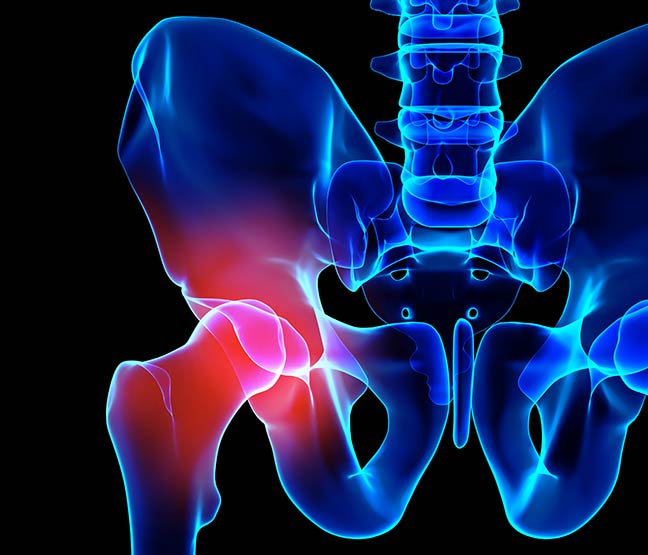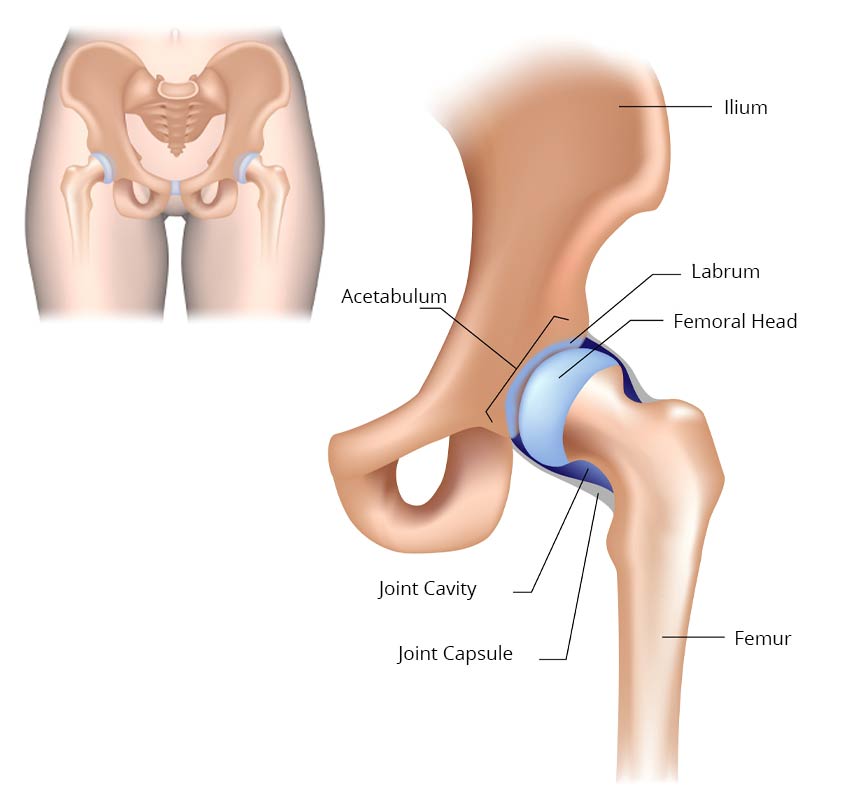Orthopedic Services
Direct Anterior Hip Replacements
Hip Replacement Surgery
A hip replacement surgery, also referred to as hip arthroplasty, is the second most common joint replacement procedure, as it is closely followed by knee replacements.
Your hip is one of your body's largest joints. It is a ball-and-socket joint. The socket is formed by the Acetabulum, which is part of the large pelvis bone.
The ball is the femoral head, which is the upper end of the thighbone or Femur. The bone surfaces of the ball and socket are covered with articular cartilage, a smooth tissue that cushions the ends of the bones and enables them to move easily.
A thin tissue called synovial membrane surrounds the hip joint. In a healthy hip, this membrane makes a small amount of fluid that lubricates the cartilage and eliminates almost all friction during hip movement.
The ligaments, or hip capsule which are bands of tissue, connect the ball to the socket and provide stability to the joint.
Hip replacement procedures are for patients who have tried all of the other treatments and are still left with significant pain during normal activities.
Arthritis
Hip osteoarthritis or degenerative arthritis of the hip is arthritis, also known as joint inflammation, in your hip joint.
Joint inflammation causes pain and swelling in your body's joints - your hip, knee, shoulder or elbow joints. There are many types of arthritis, with osteoarthritis being the most common type.
The description degenerative joint disease, also known as osteoarthritis, is used for age-related arthritis and more likely develops as people get older.
Hip replacement surgery is a surgical procedure in which the hip joint is replaced by a prosthetic implant, also called a hip prosthesis.
Hip replacement surgery can be performed as a total replacement or a hemi (partial) replacement. This surgery may also be a choice after a hip fracture or for severe pain because of arthritis.
Please click on the image or click here for information about Stryker® Mako™ Robotic-Arm Assisted Hip Replacement Surgery.
Interested in direct anterior hip replacement surgery? Click here.
Hip replacement surgery is recommended:
- If other treatments including pain medicines have not helped.
- If other you anti-inflammatory drugs or shots have not given you enough relief.
- If physical therapy, exercise and weight loss are still hard and very painful.
- If walking, even with a cane or walker, worsens.
- If daily activities such as sleeping, standing up, sitting down, bending over to reach something, affects the ability to go up and down stairs or shopping for groceries are painful.
- If your hip hurts when you are lying in bed or even when sitting still.
- If your hip pain or stiffness is consistently bothering you.
- If the pain in your hip interferes with your sleep.
About Hip Replacement Surgery Options
Robotic Total Hip Replacement Direct Anterior Approach Surgery
Direct Anterior Hip Replacement
Posterior Robotic Hip Replacement
Regular Posterior (traditional) Hip Replacement
The goal of a hip replacement procedure is to relieve a painful hip joint, making walking and movement easier.
The various forms of arthritis that may damage the hip joint, leading to a hip replacement procedure, include:
Osteoarthritis, also known as the wear-and-tear arthritis, which may be prevented if you maintain a healthy weight and follow a regular exercise plan. Exercise strengthens your muscles around the joints. This may help to prevent the wear and tear on cartilage in a joint.
Osteoarthritis occurs when inflammation and injury to a joint cause a break down of the cartilage tissue, damaging the cartilage that covers the ends of bones and helps joints move smoothly. This causes swelling, pain and deformity. Cartilage is the slick but firm, rubbery material that covers the ends of bones in normal joints. It is primarily made up of water and proteins. It functions to reduce friction in the joints and serves as a shock absorber. Cartilage may undergo some repair when it is damaged, but the body does not grow new cartilage after it is injured. The changes in osteoarthritis usually occur slowly over many years. Although there may be the occasional exceptions.
Patients with osteoarthritis of the hip may experience problems walking. A diagnosis may be difficult at first as pain can appear in different locations including the knee, thigh, buttocks or groin. You may have sharp or stabbing pain, or it can be a dull ache, and the hip is often stiff.
Rheumatoid arthritis. Caused by an overactive immune system, rheumatoid arthritis produces a type of inflammation that can erode cartilage and occasionally underlying bone, resulting in damaged and deformed joints.
Osteonecrosis. If there is inadequate blood supply to the ball portion of the hip joint, the bone may collapse and deform.
Dr. Ronald Hudanich is a board-certified orthopedic surgeon and has a long history of successfully treating patients with knee, hip, and shoulder degenerations and joint replacement surgeries. Dr. Hudanich is specially trained to restore your range of motion, ease the pain, and enable you to regain your active lifestyle with a partial, total or revised joint replacement surgical option that is best for you.
For additional questions please call us at (407) 977-4130 or visit American Academy of Orthopaedic Surgeons.


